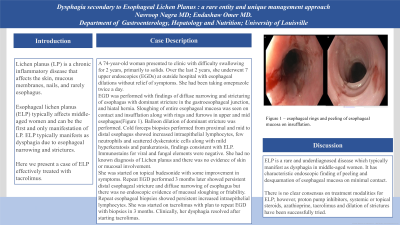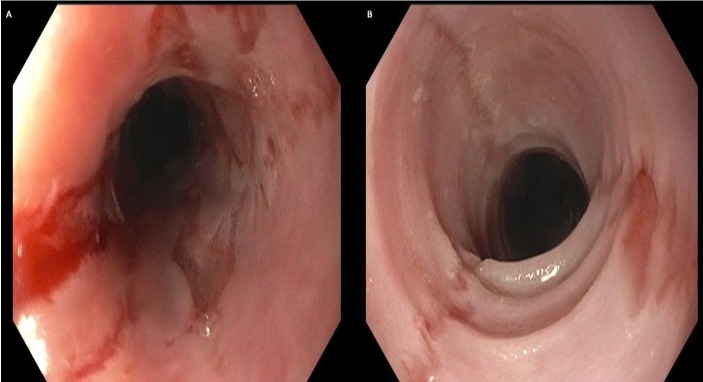Tuesday Poster Session
Category: Esophagus
P3349 - Dysphagia Secondary to Esophageal Lichen Planus: A Rare Entity and Unique Management Approach
Tuesday, October 24, 2023
10:30 AM - 4:00 PM PT
Location: Exhibit Hall

Has Audio
- NN
Navroop Nagra, MD
University of Louisville
Louisville, KY
Presenting Author(s)
Navroop Nagra, MD1, Endashaw Omer, MD, MPH, FACG2
1University of Louisville, Louisville, KY; 2University of Louisville School of Medicine, Louisville, KY
Introduction: Lichen planus (LP) is a chronic inflammatory disease that affects the skin, mucous membranes, nails, and rarely esophagus. Esophageal lichen planus (ELP) typically affects middle-aged women and can be the first and only manifestation of LP. Here we present a case of ELP effectively treated with tacrolimus.
Case Description/Methods: A 74-year-old woman presented to clinic with difficulty swallowing for 2 years, primarily to solids; therefore, had resorted to softer foods and liquids only. Over the last 2 years, she underwent 7 upper endoscopies (EGDs) at outside hospital with esophageal dilations without relief of symptoms. She had been taking omeprazole twice a day. Barium esophagogram revealed markedly delayed clearance of the barium tablet from the patient's cervical esophagus, at or just below the level of the upper esophageal sphincter. EGD was performed with findings of diffuse narrowing and stricturing of esophagus with dominant stricture in the gastroesophageal junction, and hiatal hernia. Sloughing of entire esophageal mucosa was seen on contact and insufflation along with rings and furrows in upper and mid esophagus(Figure 1). Balloon dilation of dominant stricture was performed. Cold forceps biopsies performed from proximal and mid to distal esophagus showed increased intraepithelial lymphocytes, few neutrophils and scattered dyskeratotic cells along with mild hyperkeratosis and parakeratosis, findings consistent with ELP. Immunostains for viral and fungal elements were negative. She had no known diagnosis of Lichen planus and there was no evidence of skin or mucosal involvement. She was started on topical budesonide with some improvement in symptoms. Repeat EGD performed 3 months later showed persistent distal esophageal stricture and diffuse narrowing of esophagus but there was no endoscopic evidence of mucosal sloughing or friability. Repeat esophageal biopsies showed persistent increased intraepithelial lymphocytes. She was started on tacrolimus with plan to repeat EGD with biopsies in 3 months. Clinically, her dysphagia resolved after starting tacrolimus.
Discussion: ELP is a rare and underdiagnosed disease which typically manifest as dysphagia in middle-aged women. It has characteristic endoscopic finding of peeling and desquamation of esophageal mucosa on minimal contact. There is no clear consensus on treatment modalities for ELP; however, proton pump inhibitors, systemic or topical steroids, azathioprine, tacrolimus and dilation of strictures have been successfully tried.

Disclosures:
Navroop Nagra, MD1, Endashaw Omer, MD, MPH, FACG2. P3349 - Dysphagia Secondary to Esophageal Lichen Planus: A Rare Entity and Unique Management Approach, ACG 2023 Annual Scientific Meeting Abstracts. Vancouver, BC, Canada: American College of Gastroenterology.
1University of Louisville, Louisville, KY; 2University of Louisville School of Medicine, Louisville, KY
Introduction: Lichen planus (LP) is a chronic inflammatory disease that affects the skin, mucous membranes, nails, and rarely esophagus. Esophageal lichen planus (ELP) typically affects middle-aged women and can be the first and only manifestation of LP. Here we present a case of ELP effectively treated with tacrolimus.
Case Description/Methods: A 74-year-old woman presented to clinic with difficulty swallowing for 2 years, primarily to solids; therefore, had resorted to softer foods and liquids only. Over the last 2 years, she underwent 7 upper endoscopies (EGDs) at outside hospital with esophageal dilations without relief of symptoms. She had been taking omeprazole twice a day. Barium esophagogram revealed markedly delayed clearance of the barium tablet from the patient's cervical esophagus, at or just below the level of the upper esophageal sphincter. EGD was performed with findings of diffuse narrowing and stricturing of esophagus with dominant stricture in the gastroesophageal junction, and hiatal hernia. Sloughing of entire esophageal mucosa was seen on contact and insufflation along with rings and furrows in upper and mid esophagus(Figure 1). Balloon dilation of dominant stricture was performed. Cold forceps biopsies performed from proximal and mid to distal esophagus showed increased intraepithelial lymphocytes, few neutrophils and scattered dyskeratotic cells along with mild hyperkeratosis and parakeratosis, findings consistent with ELP. Immunostains for viral and fungal elements were negative. She had no known diagnosis of Lichen planus and there was no evidence of skin or mucosal involvement. She was started on topical budesonide with some improvement in symptoms. Repeat EGD performed 3 months later showed persistent distal esophageal stricture and diffuse narrowing of esophagus but there was no endoscopic evidence of mucosal sloughing or friability. Repeat esophageal biopsies showed persistent increased intraepithelial lymphocytes. She was started on tacrolimus with plan to repeat EGD with biopsies in 3 months. Clinically, her dysphagia resolved after starting tacrolimus.
Discussion: ELP is a rare and underdiagnosed disease which typically manifest as dysphagia in middle-aged women. It has characteristic endoscopic finding of peeling and desquamation of esophageal mucosa on minimal contact. There is no clear consensus on treatment modalities for ELP; however, proton pump inhibitors, systemic or topical steroids, azathioprine, tacrolimus and dilation of strictures have been successfully tried.

Figure: A- Peeling of esophageal mucosa; B- Esophageal rings
Disclosures:
Navroop Nagra indicated no relevant financial relationships.
Endashaw Omer indicated no relevant financial relationships.
Navroop Nagra, MD1, Endashaw Omer, MD, MPH, FACG2. P3349 - Dysphagia Secondary to Esophageal Lichen Planus: A Rare Entity and Unique Management Approach, ACG 2023 Annual Scientific Meeting Abstracts. Vancouver, BC, Canada: American College of Gastroenterology.
